
| Volume 20, Issue 3 | March 21, 2018 |





|
In this Issue:
|

| Volume 20, Issue 3 | March 21, 2018 |





|
In this Issue:
|
About 55 years ago, I bought my own car, a classic VW Beetle, for around $600, paying cash for it, and then, on my first drive with my new auto (really somewhat used, but a fresh set of wheels and the best and only car I'd possessed to that point), just two minutes into this novel experience as an actual car owner and less than a mile from my apartment, had my first automobile collision. I was not used to the vehicle's brakes, but, more to the point, was not following the car ahead at a safe driving distance. It braked suddenly as the light was turning red, and I ran right into it. I was incensed its driver had so inconsiderately stopped for the red light.
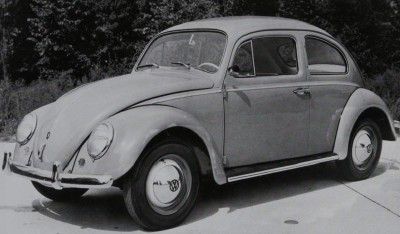 Showing my maturity, I blamed him for the mishap, especially since his machine was undamaged, while my "Bug" had lost a piece of the front bumper. I demanded he either pay for the damages or we call the police and get a report of the incident. I was confident it would show he had been in the wrong and that his insurance ought to make restitution. In those days before smart phones, even finding a way to quickly call the authorities was problematic. Traffic was backing up behind us. The older driver of the horseless carriage ahead had long ago lost patience with this idiot kid. I hadn't a leg to stand on, but he had no time for fools. He angrily reached in his pocket, found a quarter, handed it to me, got back in his car, and sped off. My face having thus been saved (for, after all, the guy who damaged my car had paid up!), I picked up the broken bumper piece, got in my car, and drove off as well. Later I used his quarter to buy a bolt to replace the one broken in the wreck, and I easily reattached the piece that had fallen off in our accident. All's well that ends well, I figured.
Showing my maturity, I blamed him for the mishap, especially since his machine was undamaged, while my "Bug" had lost a piece of the front bumper. I demanded he either pay for the damages or we call the police and get a report of the incident. I was confident it would show he had been in the wrong and that his insurance ought to make restitution. In those days before smart phones, even finding a way to quickly call the authorities was problematic. Traffic was backing up behind us. The older driver of the horseless carriage ahead had long ago lost patience with this idiot kid. I hadn't a leg to stand on, but he had no time for fools. He angrily reached in his pocket, found a quarter, handed it to me, got back in his car, and sped off. My face having thus been saved (for, after all, the guy who damaged my car had paid up!), I picked up the broken bumper piece, got in my car, and drove off as well. Later I used his quarter to buy a bolt to replace the one broken in the wreck, and I easily reattached the piece that had fallen off in our accident. All's well that ends well, I figured.
Life is not without its ironies. A few years later, I was working at a training post for the Department of the Army as a safety specialist intern. Part of my job was to teach new 18- and 19-year-old recruits the National Safety Council's Defensive Driving Course. Naturally, I never told any of the students about my own earliest accident.
As my wife, Valerie, can tell you, I am not the best driver in the world, but luck has been with me, and I have had no further accidents in which I was at fault (for an incident when I had the right of way and a truck driver ran into my then Nissan Sentra, hit and run, does not count) till shortly after I had bought my nicest car to date, a then recent year, low mileage Toyota Corolla LE, the transportation I use today.
On my last solo driving vacation, mere weeks after getting the Toyota, I misjudged my passenger side clearance when pulling out of a parking space and scraped the finish on an adjacent building. Once again the obstruction was completely undamaged. However, my "perfect" transportation now had ugly gouges as if a bear claw had swiped across the right doors. Happily, my birthday was coming up, and Val is something of an artist. She got exactly the styles of paint or undercoat needed for the damaged exterior and gradually filled in the "claw marks" till they are hard to see unless one is looking closely.
Still, given how accidents keep happening to the newer cars in which I have the most emotional investment, maybe I'd better put off getting another for quite awhile!
There are some plants for which favorable attributes are difficult to muster. Poison ivy probably tops the list. From our anthropocentric point of view, this plant is nothing but an ugly zit on Nature's fair skin. The same goes for Ragweed, Nettles, Cat Brier, Bedstraw, Sand Burs and Thistles. Come to think of it, poor Mother Nature has quite a complexion problem. But we must remember that beauty is in the eye of the beholder and it is only skin deep. Beauty, as such, holds no real intrinsic value and serves no practical purpose other than to please us, which, of course, isn't really always practical. As I joke about the disconnect between a highly evolved ecosystem, with its myriad interrelated biological bits, and our often simplistic notions of good and bad inspired by a very narrow view of the world that surrounds us, it seems almost impossible to elucidate how that which might appear to be worthy only of disdain can actually be an integral component in the environmental network. Therefore I won't try to explore more than a few small examples.
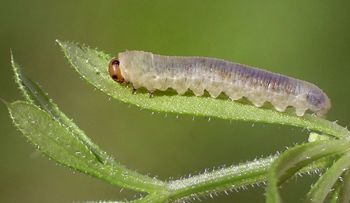 Sawfly larva on Bedstraw |
The idea that even weeds are important in some way came to mind recently because it is almost spring here in central Texas and the Bedstraw (Galium sp.) is bustin' out all over. This plant is a prolific annual that goes by various names, including Cleavers, Stickyweed, Grip Grass and Velcro Plant. It rivals kelp in its growth capacity and overtakes many other plants in the cool temperatures of late winter. Given adequate rain, it forms large patches in our backyard, and, true to its various names, it manages to even invade our house by way of the fur on our wire fox terrier. She is not oblivious to it, and usually tries to disengage it from her legs, which results in it wrapping around her muzzle where it is obviously even more annoying. It also sticks to socks, shoe laces, pant legs and human skin.
In spite of it's negative aspects, Bedstraw is actually sort of lovely, if one doesn't touch it. The bright green stems are surrounded by myriad whorls of delicate leaves that look more like an ornamental house plant than a noxious weed. But there I go mentioning an inconsequential attribute again; I'm only human and am easily distracted.
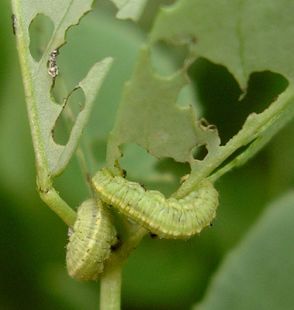 Weevil larvae on Burclover |
Another such tiny glimpse of the bigger picture occurs with Bur Clover (Medicago sp.). A sprawling yellow-flowered relative of Alfalfa, Bur Clover is often the bane of fastidious gardeners and home owners. The wide round leaves crowd out grass and other plants, while the prickly seed pods (the bur part) are another nuisance hitchhiker on everything from clothing to pet fur to human hair. Here in Texas, this plant often grows along with our venerated Bluebonnets (which are weeds we deem to be desirable, but that's another story) and can crowd them out.
As Bur Clover is mostly something that we walk on, many people never really look too closely at it. However, there is a weevil that relishes this plant, and just about wherever it grows undisturbed there are signs of the beetles' consumption. Again, it is a minute fraction of the relationships that result in our biosphere's functioning but clearly illustrates the interconnectedness theme.
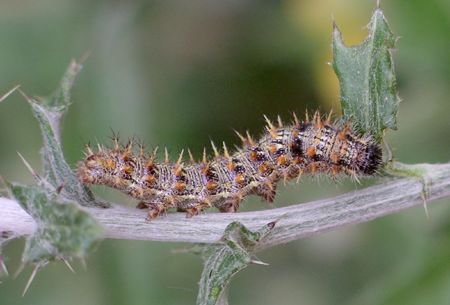 Painted Lady caterpillar on Thistle |
Although thistles have showy purple flowers, our sensibilities find inadequate compensation for the extraordinarily prickly leaves and stems. Thistles not only possess highly effective protection, but they are also large plants, often growing to a height of several feet. Trying to navigate a field dense with this vegetation is not particularly pleasant. But the tender greens under the spiky weaponry are a banquet for various insects, including beetles, flies and moth caterpillars. They are also a favorite food of the Painted Lady butterfly. The larvae construct messy webbed retreats within the thorns and thrive on the succulent flesh at hand. One upshot of the close ties between plant and animal is that the caterpillar has evolved to blend into its bristly background. No venom is present in the spines, and it is safe to handle this species, but the dense array of projections on the insect's body hide it from predators' prying eyes as well as keep small predators and parasitoids at bay.
While I've only mentioned annuals so far, there is a very brawny perennial vine that has few, if any, human devotees. Cat-brier, or Green Brier, (Smilax sp.) sends deep roots into our rocky soil, and grows ever larger with each passing year. If cut to the ground, it returns with a vengeance, thicker
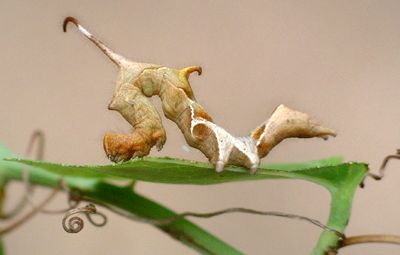 Curve-lined Owlet caterpillar on Cat-brier |
One more intriguing example in this survey of disreputable vegetation and their closely associated creatures is that of the very bothersome nettle called Noseburn and the delicate Common Mestra butterfly. Like other kinds of nettles, Noseburn (Tragia sp.) possesses a thick pelt of fragile spines that break off when touched, releasing an irritating chemical that causes sharp, burning
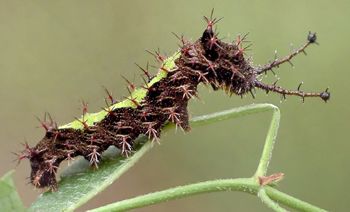 Common Mestra caterpillar on Noseburn |
Just because a plant appears useless, or even malevolent, to us, doesn't mean it is less worthy of existing. The ecology of our planet is such that no organism survives without connections to its fellow associates within the biome. All it takes to discover these links is an open mind, a little curiosity, an ability to research, a bit of imagination in the mystery-solving department and a lot of patience. The elegance, and beauty, of a healthy habitat becomes indistinguishable from the efficiency and productivity of the flora and fauna within it.
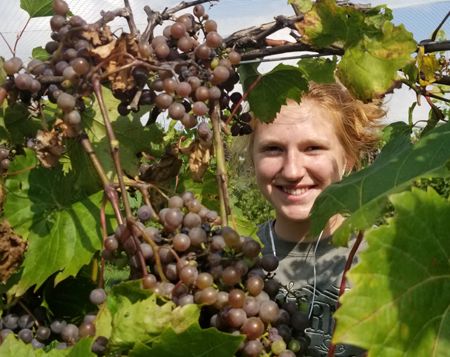
Despite the hard work involved, there is still time for a light-hearted moment during the annual grape harvest in Wisconsin as Isabella peers through the bountiful crop on Sept. 24, 2017. The fruit is sold to a local wine maker. Isabella's mother, Vicky, remarked that the take was pretty good that year; it didn't quite pay for the new metal roof on their house, but it sure helped.
![]()
| (The Terra Tabloid is a venue for the discussion of issues pertaining to the past, present, and future of our planet and human interaction with it.) |
The Amazon basin (a tropical rainforest, river, and jungle system that encompasses 8 Latin American countries, 1100 rivers and tributaries, 2.9 million square miles, and like a heart beating circulatory liquid throughout a body, pumps an average of 32 million gallons of water into the Atlantic Ocean every second) is about the size of the lower 48 United States. We think of it as a stable fixture of the Western hemisphere, yet it is in a state of constant change.
Before the rise of the Andes Mountains of Peru, for instance, for a time it emptied into the Pacific.
Far more recently, a portion of the current tropical rainforest canopy was not there. Instead, indigenous tribes had a thriving yet sustainable agriculture where now millions of trees are more dominant. Up to around 8 million people are believed to have lived in Amazonia before Columbian times. Using methods that combined turning local wood into charcoal and fertilizing with it plus mulching and adding waste to areas for planting, they are thought to have maintained a balance between the tropical flora and native peoples' food source needs. Besides enjoying nutritional contributions from hundreds of uncultivated Amazonian flora, they raised scores of crops in the region, including sweet potatoes, palm, pineapple, cacao, tobacco, cassava, hot peppers, fruit trees, etc. The early indigenous farming practices are thought to have continued for thousands of years, until diseases brought by Europeans decimated Native American populations, and the jungle took over in many of these formerly inhabited areas, producing there the landscape more familiar to us.
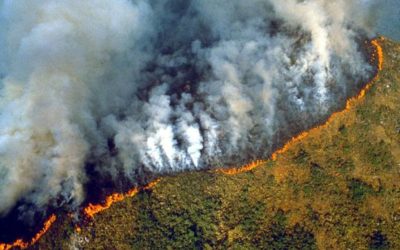 Now that too is giving way to deforestation. Huge swaths are being cleared for highways, urban development, valuable hardwoods harvesting, cattle ranching, soy, palm, and other crops, and, to a lesser extent, for subsistence farming.
Now that too is giving way to deforestation. Huge swaths are being cleared for highways, urban development, valuable hardwoods harvesting, cattle ranching, soy, palm, and other crops, and, to a lesser extent, for subsistence farming.
Climate change may now be combining with rapid deforestation to bring about alterations to the Amazon system. Droughts and floods are occurring more often. With the former come more frequent and extensive forest fires. Further, the rainy season is becoming shorter, lengthening the dry season. If the latter gets to be 5-7 months in length, scientists believe the southern Amazon rainforest region will change to savannas. Trees will lack enough annual moisture and so will die. Over much of the southern Amazon basin the rainforests are already at risk due to shrinking wet and lengthening dry seasons. A major shift of the area from tropical rainforest to grassy plains would have ramifications for weather as distant as Texas.
These apparent changes may be only the canary in the coal mine, though, an indication of potentially negative things to come, for if the globe is warming significantly the whole Amazon Basin system will likely be affected, with unforeseeable consequences. What happens when a metaphorical beating heart of rainforest water flow is altered or the lungs-like inspiration and expiration of the vast Amazonian flora is no longer influencing the chemistry of the atmosphere? Just as there are vast flows of liquid water now out of the Amazon, so too there are rivers of moisture laden air affecting the climate both near and far. Scientists do not have all the answers yet. There is speculation, however, that with a less healthy Amazon system some of the major ocean currents may be changing and that a more rapid increase in atmospheric carbon dioxide would occur. Along with more rapid melting of the Greenland ice sheet, there is concern that the warming Gulf Stream, vital to keeping northern Europe out of deep freeze Arctic tundra-like conditions, may slow or stop. At the same time, hurricanes, powered by increased evaporation over the oceans, would become more powerful and occur with greater frequency over the same general area. This apparent trend is already causing insurance companies to factor in more severe damage from storms like Harvey, Irma, Jose, and Maria when calculating appropriate premiums to change in coastal areas.
In the longer term, the amazing average discharge flows of the Amazon and its tributaries are likely to decline, of course, as that region experiences loss of rainfall. Major changes in rainfall patterns in the Amazon could also have ripple effects on global weather. It will at least be interesting to see how this plays out.
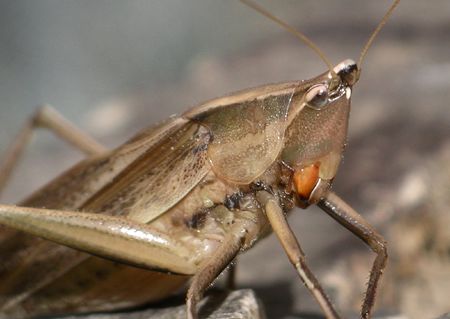
While we have several kinds of katydids in our area, only the broad-tipped conehead (Neoconocephalus triops) is active early in the year. On warm nights beginning in March, the long, trilling call of the males can be heard, usually on vegetation close to the ground. This is a large insect, reaching a length of about 2 inches. Although the large jaws are usually used for chewing on grass seeds (and occasionally other insects), a captured individual will not hesitate to bite, and they can do so quite effectively. The specimen shown above is a male; even though the rear of the abdomen (which would have a long ovipositor if it were female) is not visible in the photo, the color is enough to know the sex. Every green conehead I've seen in Austin has been female, while every male has been brown.
Last month's topic was manias then and now, so to give a bit of balance it seems only reasonable to also cover assets that are hardly popular at all. If the former kinds of venture are too often overvalued, might the latter be now more promising for long-term total returns? As the disclaimer indicates, I am not a professional, so please take my comments here with a grain of salt. Nonetheless, for what they are worth, here are a few of my current guesses as to ways to not come off too badly if investing today:
1. Cash under the mattress, money market accounts, short-term Treasuries, or other forms of secure cash reserves. While it is true these are hardly in great demand just now, it is also accurate that they pay little if any dividend to their holders and so might appear to have no value as investments at all. In fact, however, they can be worth their weight and more (for most cash is not all that heavy) in gold. The reason is simply that when, as always occurs sooner or later, the major markets plummet they inevitably will take the prices of good stocks down with them. If the companies which have issued the stock are financially strong, growing their cash flow nicely over time, then they may at that time be worth taking a investment significant plunge, and one's previously dismissed liquid reserves at that time will come in very handy and likely prove lucrative after all.
2. Intermediate-term corporate bonds. Bonds may be purchased outright or via closed-end funds or mutual funds. A good vehicle for this last means of acquiring bond value is the Vanguard Intermediate-Term Investment Grade Fund Investor Shares (VFICX). This fund has an initial minimum investment of $3000. (Another, the Admiral Shares version [VFIDX], has a bit lower fees, but requires a minimum investment of $50,000.) VFICX, at 3.13%, does not currently have a high yield. What is more, investors probably should be aware that as interest rates and/or inflation increase the initial investment is likely to drop to some degree. However, if one is gradually setting aside funds at regular amounts and intervals, for instance in an IRA or a 401k account, the investor can benefit from the bond market's ups and downs, getting more shares when the price is lower and so reducing the overall cost basis. In addition, VFICX has a decent long-term record. A $10,000 investment a decade ago, left untouched and with all distributions reinvested, would be worth about $16,000 today. Given that the stock market is overvalued, likely to decline substantially in at most the next several years, this might be a much better place to put one's hard earned dollars, all things considered, at least till after such a major drop in stock prices.
| Company | Ticker Symbol | Recent Price | Dividend Yield |
|---|---|---|---|
| Aircastle, Ltd. | AYR | $20.86 | 5.37% |
| AmTrust Financial Services | AFSI | $12.35 | 5.51% |
| WPP plc, ADR | WPP | $96.78 | 3.98% |
3. Beaten Down Stocks. For the more adventurous, here are a few equities that currently seem sufficiently out of favor as to maybe deserve a serious look, due to their potential over the next few years.
There are few specific guarantees in investing. Yet by focusing more on what is not just now so popular we can on average do better in the long-run than by investing in what is seen by the hoi polloi as the current cat's meow.
| |||||||||
|
Spring (which arrived on Mar. 20) in central Texas is usually a pleasant season, and its approach has been marked by wild fluctuations in temperature. We've experienced highs near 90°F in close proximity to lows in the 40s. The flowering trees are loving it, and the air is filled with the scent of Agarita, Mexican Plum and Texas Mountain Laurel. At the same time, the cold is keeping chiggers at bay, which is always cause for celebration!
May everyone have a happy Easter. The shifting holiday amusingly happens to coincide this year with April Fool's Day. Double festivities may ensue!
|
| For others who may have chanced upon this site, larvalbug bytes is a monthly family-and-investment newsletter, put out by an old codger and sweet thing, with sometimes a little help as well from our engaging pooch, Peri. We invite readers' comments by and would also be happy to readers when new issues are published. Articles and stories from back issues are available in our archives. |

|
Copyright © 2018 by LARVALBUG
"Spring Bugs" and larvalbug web design by Valerie.
![]()